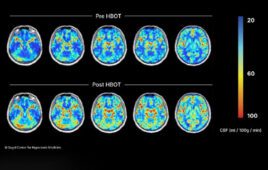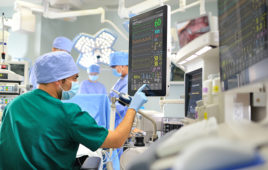Just like workers in a factory, enzymes can create a final product more efficiently if they are stuck together in one place and pass the raw material from enzyme to enzyme, assembly line-style. That’s according to scientists at Cornell’s Baker Institute for Animal Health, the first team to recreate a 10-step biological pathway with all the enzymes tethered to nanoparticles.
They were inspired to study how nanoparticles could gain biological functions through the enzymes that drive sperm tails, which turn sugar into lactate and energy so quickly that sperm can speed along at five body lengths per second.
“Sperm have a highly efficient energy-producing system,” said the study’s lead author, Chinatsu Mukai, a postdoctoral research associate. In the Baker Institute laboratory of Alex Travis, associate professor of reproductive biology, Mukai and others had been studying metabolism and sperm function. Travis had the idea to mimic the way sperm tail enzymes are attached to a solid support in an attempt to achieve the same sort of efficiency on small human-made devices.

Graphic depicts the tethered enzymes and free-floating enzymes. (Credit: Cornell University)
In most cells, the majority of enzymes that carry out the process of turning sugar into energy, called glycolysis, are floating around, picking up the molecules they work on as they happen along. But in sperm, the enzymes that carry out glycolysis have special regions that attach the enzymes to a solid protein scaffold that lies just beneath the membrane covering the cell and runs most of the length of the tail.
“Sugar comes in through the membrane, hits the enzymes immediately underneath, and then is processed and passed down the line, giving energy production in a high-throughput fashion,” said Travis.
The system Mukai, Travis and their team developed works in much the same way: The sugar molecule is processed from start to finish by enzymes attached to nanoparticles. Compared with enzymes floating free in solution, the tethered enzyme system processed glucose to the end product, lactate, more efficiently, leaving lower concentrations of intermediate products than the free-floating enzyme system. Getting a 10-step pathway to function with all the components tethered is an exponential increase over previous studies, which reported a maximum of two to three steps.
If the work can be enhanced to be a net producer of energy, there could be a number of practical applications, Travis said. In sperm, the energy is used for swimming and the signaling that allows it to fertilize an egg, but in nanobiotechnology, the energy could be used to power devices that carry out a variety of jobs.
“Imagine devices the size of blood cells, each holding a chemotherapy drug. If outfitted with this kind of engine, then the devices could make their own energy from sugar in the bloodstream. Using molecular pumps powered by that energy, the devices could kick out that drug cargo at defined rates, and specifically where it’s needed, such as at the site of a solid tumor,” said Travis. His team has already applied the concept of tethered enzymes in a device to detect signs of stroke or traumatic brain injury in blood samples, a technology that he and his lab are planning to commercialize.
It may even represent a step closer to realizing the potential of artificial cells, said Mukai.
“You can’t make an artificial cell without metabolic pathways, so this is progress in that direction,” she said.




